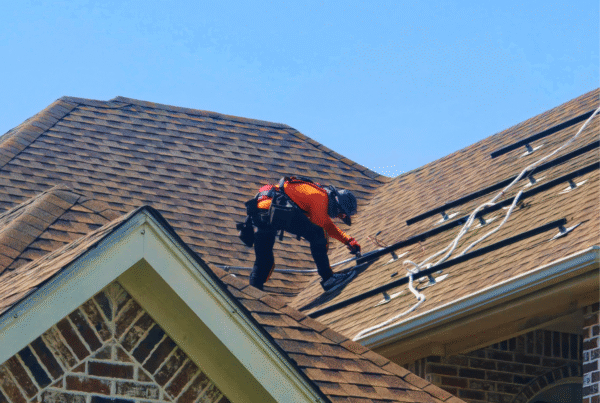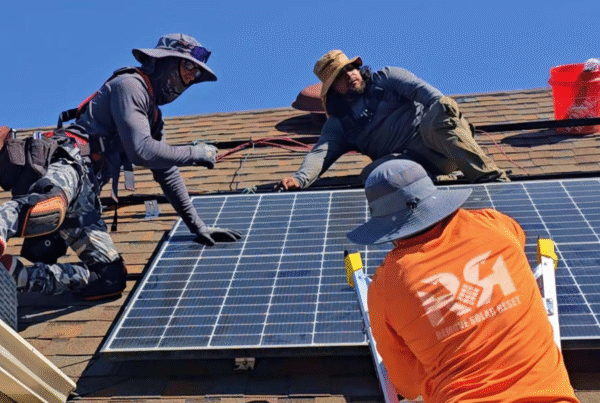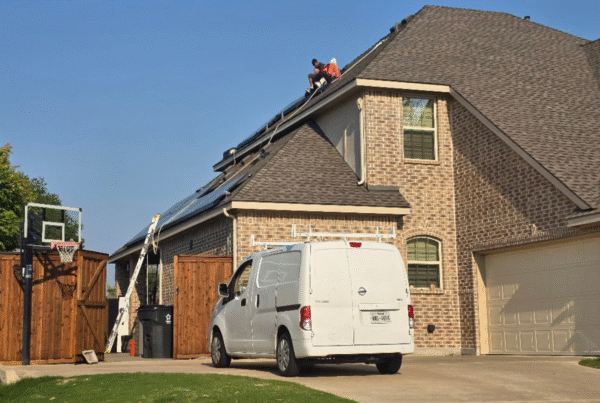Navigating Solar Panel Removal Permits in Texas: What Homeowners Should Know
Updated: October 2025
Homeowners searching for what permits are required for solar panel removal near me in Texas often find the process more complex than expected. From city inspections to roof work regulations, understanding permit requirements is critical to ensuring a safe and compliant removal.
As of October 2025, Texas solar removal regulations require specific permits for electrical disconnection and roof alterations tied to solar uninstall projects. Improper permitting can cause delays, fines, or insurance claim complications.
Fast, Safe, Reliable Solar Panel Removal & Reset — Done Right, Every Time. Protect Your Investment Today. Call 469-283-1089 or Request a Free Quote.
Quick Answer
In Texas, solar panel removal generally requires both an electrical permit for system disconnection and a roofing permit if roof work is involved. These permits ensure compliance with local city codes and safety regulations. Consulting your city’s building department early helps avoid costly project delays.
Understanding Solar Removal Permit Requirements in Texas
In Texas, solar panel removal frequently triggers permit requirements at the city or county level. The most common permits are:
- Electrical Permit: Required for safely disconnecting the solar system from your electrical panel per state electrical codes.
- Roofing Permit: If roof work is part of panel removal or reset (e.g., reroofing beneath panels), local building codes often mandate a roofing permit.
- Mechanical or Structural Permit: Occasionally required if panel mounts or supports need modification.
Cities such as Dallas, Austin, Houston, and San Antonio have specific application processes via their building departments. Consult your local building authorities early to clarify exact requirements.
Our Permitting & Removal Approach
At Remove Solar Reset, we specialize in navigating city permit for solar uninstall processes to ensure compliance and speed. Our team holds a Master Electrician license and is fully insured with workers’ compensation, adhering to OSHA 1926.501 fall protection standards and local code mandates.
We coordinate directly with permit offices, often securing permits within days, reducing your project downtime. Our certified electricians (Tesla, Enphase, SolarEdge) follow manufacturer guidelines for disconnections and panel resets.
Learn more about our comprehensive solar panel removal process to protect your roof and system warranty.
Common Mistakes & Permit Pitfalls in Solar Panel Removal
- Starting removal without permits leading to project halts or fines.
- Failing to acquire roofing permits when replacing or repairing roofs beneath panels.
- Using unlicensed contractors without proper permits or insurance coverage.
- Neglecting electrical permit applications causing inspection failures and liabilities.
Avoid these costly errors by consulting licensed professionals experienced in Texas solar removal permit requirements.
Step-by-Step Safe Solar Panel Removal Process (Case Study Included)
Our typical removal process in Texas includes:
- Initial site inspection and documentation
- Scheduling utility disconnection
- Roof safety setup with fall arrest systems
- Careful disconnection of electrical components
- Panel detachment using specialized tools
- Packing and secure storage or relocation
- Final 42-point inspection
- Full project documentation for insurance or warranty claims
For example, a recent Austin project included removal of 18 panels for a reroof. We obtained the necessary electrical and roofing permits, completed removal in under 6 hours, and passed all city inspections on first attempt.
Why Choose Remove Solar Reset for Your Texas Project
Our leadership has 9+ years solar experience backed by
- Master Electrician license
- Tesla, Enphase, SolarEdge certifications
- Full general liability and workers’ compensation insurance
- 60% faster removal times than industry average (4 vs 10 hours)
- Zero roof damage claims in 2025 across 500+ projects
- 99.8% warranty retention rate
Discover more about our credentials and commitment.
DIY vs Professional Solar Panel Removal: Permit & Safety Comparison
| Aspect | DIY Removal | Professional Removal |
|---|---|---|
| Permitting | Often skipped or unaware | Fully handled and documented |
| Safety Compliance | High risk of accidents | OSHA & manufacturer standards met |
| Warranty Protection | Likely voided | Maintained through certified process |
| Timeliness | Prolonged and uncertain | 60% faster completion times |
Permit Fees, Costs & Insurance Considerations
| Permit Type | Typical Fee in Texas | Purpose |
|---|---|---|
| Electrical Permit | $100 – $250 | System disconnection and reconnection approval |
| Roofing Permit | $150 – $300 | Roof alterations related to solar removal/reset |
Ready to protect your investment with certified removal? Call (469) 283-1089 for a free estimate tailored to your Texas project.
Insurance policies may require documented permit compliance for claims related to solar system removal caused by storm damage or upgrades. Our full documentation helps streamline your insurance process.
Best Time to Obtain Permits & Schedule Removal
Though solar panel removal permits can be secured year-round, planning during mild weather months (spring and fall) reduces weather-related risk and scheduling delays. Texas storm seasons in late summer/early fall can surge permit demand.
Local Texas Context: Cities, Storms & Codes
Different Texas cities enforce varied permit requirements. For example, Dallas requires electrical and roofing permits for solar uninstall tied to roof work. Houston may add additional inspections after storm damage. Remove Solar Reset serves all major Texas metro areas, customizing permit support to local codes.
Frequently Asked Questions about Solar Removal Permits
What is the average cost of removing solar panels?
Typical solar panel removal costs range from $2,000 to $4,500 depending on system size and complexity. This estimate includes labor, permitting fees, and equipment use. Larger systems or those requiring roof permits may increase costs. Contact us for a free estimate specific to your project.
How do I get solar panels removed?
Begin by hiring a licensed solar removal company experienced with local permits. The process includes permit acquisition, utility disconnection approval, safe panel removal, and documentation. DIY removal is not recommended due to safety and warranty concerns.
How much for solar panel removal?
Solar panel removal prices vary but typically cost between $2,000 and $5,000. Factors include system size, roof complexity, and permit needs. Pricing also depends on whether reinstallation or relocation is required. Contact us for detailed estimates.
How do I get rid of my old solar panels?
Old or damaged solar panels should be removed professionally with proper permits. Many companies recycle panels per state and federal guidelines. Dispose or resell only through certified channels to avoid environmental harm.
Can I remove solar panels myself?
Removing solar panels yourself is not recommended due to electrical hazards, fall risks, and permit violations. Professional removal ensures safety, compliance, warranty protection, and proper disposal or reset.
How long does it take to remove solar panels?
Professional solar panel removal typically takes 4-6 hours for standard systems with 10-20 panels. Larger or more complex setups may require a full day. Factors include roof pitch, mounting method, and weather conditions.
Will removing solar panels damage my roof?
If not done correctly, panel removal can damage roofing materials. Licensed professionals use specialized equipment and follow roof work solar removal permits to ensure no leaks or structural harm.
How do you uninstall solar panels for roof replacement?
Uninstalling panels for a roof replacement requires both electrical and roofing permits. The process involves safely disconnecting the system, detaching panels, and storing them until the new roof is installed and panels are reset.
Can old solar panels be recycled?
Yes, many materials in solar panels can be recycled legally in Texas. Professional companies follow environmental regulations to reclaim glass, metals, and silicon while disposing of hazardous components properly.
Does insurance cover solar panel removal after storm damage?
Insurance policies often cover removal and reinstallation after storm damage if permits and documentation are provided. Working with licensed professionals ensures proper claims processing.
What certifications should a solar removal company have?
Look for Master Electrician licenses and certifications from major manufacturers like Tesla, Enphase, or SolarEdge. Ensure companies hold full liability and workers’ compensation insurance for protection.
Is removing solar panels dangerous?
Yes, it involves electrical risks and working at heights. Certified professionals follow OSHA safety protocols and use fall protection to mitigate hazards during removal and reset.
Do solar removal services include reinstallation?
Many services offer removal and reinstallation packages to avoid system downtime. Proper permits and documented reset procedures ensure warranty and performance retention.
Can I sell used solar panels after removing?
Used panels can be sold if functional but should be inspected, certified, and recycled if damaged. Check local regulations regarding resale and environmental compliance.
How do I document solar panel removal for insurance claims?
Documentation includes permits, inspection reports, removal photographs, and invoices. Professional companies provide comprehensive records to support your claim.
How much does it cost to remove and reinstall solar panels for a new roof?
Combined removal and reinstallation may cost $3,500 to $7,000 for average residential systems. Factors such as permits, roof complexity, and system size influence pricing. Contact us for precise quotes.
What happens if I don’t remove solar panels before roof replacement?
Failing to remove panels can lead to roof damage, voided warranties, and inspection failures. Permits require solar removal before roof work to maintain structural integrity and code compliance.
Do I need a permit to remove solar panels in Texas?
Yes, at minimum, an electrical permit is usually needed. Roofing or mechanical permits may also apply depending on project scope and local code. Verify with your city’s building department.
How do I find a licensed solar removal company near me?
Search for companies with Master Electrician licenses, manufacturer certifications (Tesla, Enphase), and insurance coverage. Online reviews and local building department referrals help identify reputable professionals near me in Texas.
Can solar panels be removed in winter/summer?
Solar panel removal can occur year-round, but milder seasons like spring and fall typically offer safer roof conditions and permit approval efficiency in Texas.
Related Resources & Guides
Explore these related articles to learn more about solar panel services in Texas:
- Five Essential Tips for Replacing Your Roof with Solar Panels — Key advice for integrating roof projects with solar systems
- Four Essential Tips for Reroofing Your Home with Solar Panels — How to manage reroofing alongside solar uninstall and reset
- Our Solar Panel Removal and Reinstallation Process Explained — Stepwise guidance on our certified removal methods
- Frequently Asked Questions about Solar Panel Services — Answers to common concerns around solar removal and permits
Schedule Your Certified Solar Panel Removal & Reset Today
Professional Solar Panel Removal & Reset You Can Trust — Fast, Safe, and Fully Insured. Protect your warranty and avoid costly roof damage. Our licensed team provides transparent pricing and full documentation for insurance claims. Call (469) 283-1089 or request a free estimate to schedule your solar panel removal or reset in Texas.
Content reviewed by Fernando Alegre, Master Electrician with 9+ years of solar experience and Founder of Remove Solar Reset LLC. Certified by Tesla, Enphase, and SolarEdge. Technical sources: U.S. Department of Energy (energy.gov), OSHA safety standards (osha.gov), and manufacturer warranty guidelines.






